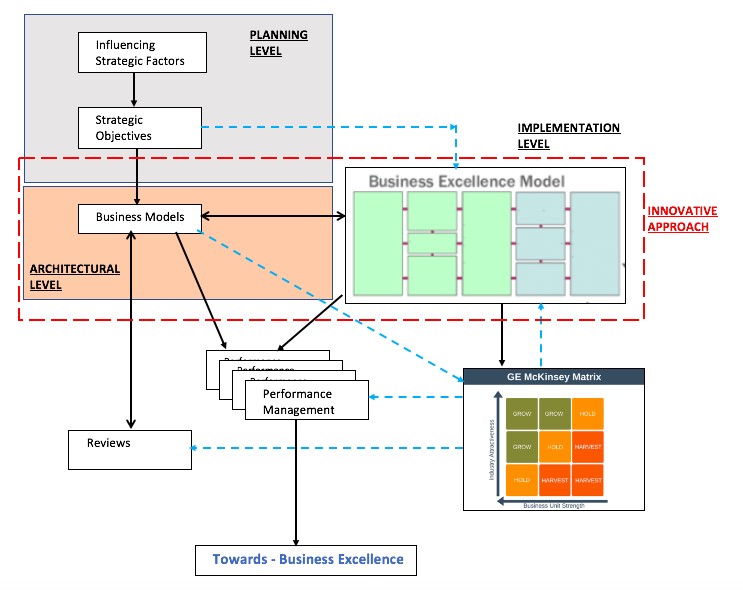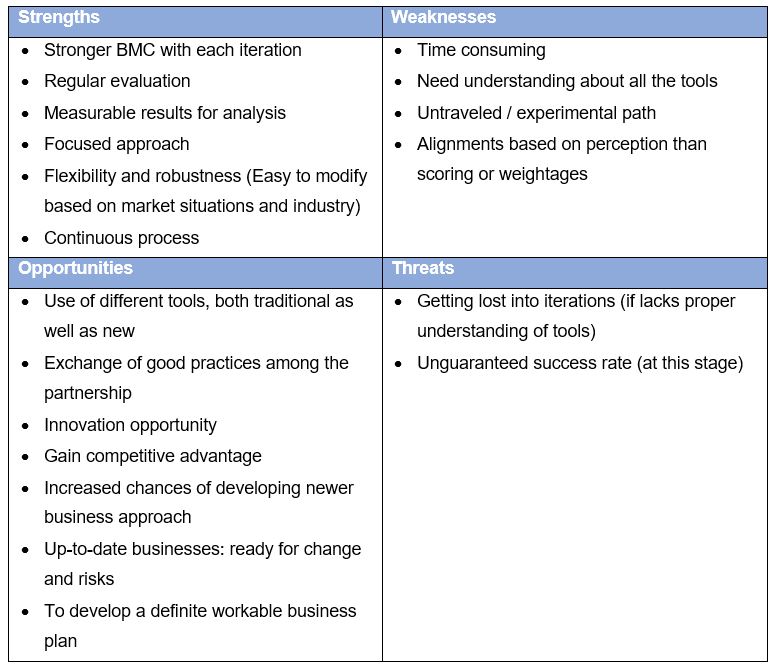The Baltic Sea Food project was undertaken due to various challenges faced by local food businesses in the Baltic Sea Region. The main objective of this project was to improve the operational effectiveness by collecting and analyzing the data in the Baltic Sea Region. Development of business model(s) was critical for creating improved business solutions for these local food businesses. This article proposes an approach for conceptualization of business models through business excellence model and provides a strategic implementation framework for achieving operational effectiveness and business excellence. This innovative approach is aimed at prioritization of strategies to yield better outcomes.
Authors: Shrusti Jarde & Brett Fifield
Baltic Sea Food Project
The EU and Interreg funded Baltic Sea Food (BSF) project aims at developing more systematic approach to bring value to all the possible stakeholders involved (Interreg Baltic Sea Region 2017). BSF project is divided into phases. Phase–I to collect information about local food business scenario, challenges faced etc. In phase-II, business model(s) are developed while in the last phase piloting and remodeling of these business model(s) is undertaken to develop most financially viable approach.
Problem Space
Market orientation and awareness of market strategies have become more important not only for investors but also for the local food businesses in order to succeed (Lund & Noell 2002). This article serves as a guideline for how to implement business models successfully and how to measure their performance (Jarde 2019). The strategy framework and recommendations provided through this article can guide local food businesses in strategically prioritizing and implementing developed business models. Hence, research objectives are to first map the current situation in local food business in Baltic Sea Region (BSR) and then to provide innovative approach in conceptualizing business models through business excellence model (BEM) for achieving business efficiency.
Business logic and Strategy
The big difference between business model and strategy is, the focal point of business models is creating value for target customers. Operational effectiveness and sustainability is important but not sufficient (Porter 1996). It is important to know that, strategies come in planning as well as in implementation phase of business logic (Osterwalder & Pigneur 2010) and based on objectives strategic tools are chosen. Below image reflects, how various excellence models and strategy tools, are applied in the business logic triangle throughout this article. This aims at understanding the purpose of business model while connecting it with business strategy and progressing it towards the business excellence.

Image 1. Business study logic developed for BSF project (Jarde 2019)
Business excellence model
Prior developing BEM, it is important to develop a basic operational business framework. The local food businesses can adapt two different approaches as their basic business operations to generate revenue. Direct approach connects local businesses directly to the end consumers. While an indirect approach establishes a link with businesses as well as private customers.
To develop a business excellence strategy model, inputs from strategic factors identified and the list of existing barriers to overcome are considered. By using EFQM model, the framework of business excellence strategy model is presented. The model is developed based on the collective findings from all 10 countries’ empirical study.
Business model implementation
This article proposes an innovative strategic approach for BSF Phase III i.e. ‘Conceptualizing business model through BEM’. Many practitioners get confused with how to implement these business models to achieve desired results or to gain competitive advantage (Casadesus-Masanell & Ricart 2010). Some businesses are more profitable than their competitors, even if they apply same strategies (Nielsen 2010). Hence, conceptualizing business models using BEM plays a significant role in not just achieving business excellence but also in effective implementation of these business models to achieve desired results.
The various components for Business model canvas (BMC) and BEM are analyzed to identify some common aspects and to fulfill their respective objectives, so that they can be mapped with ‘Enablers’ and ‘Results’ of EFQM.
After business excellence strategy model is developed, it is important to prioritize the strategies identified. Evaluate market competitive position of each factor. Rate and position these factors in the business strength and market attractiveness framework for developing GE-McKinsey nine-box matrix. The positioning is done based on market and business understanding, past experiences, importance of factor etc. Once strategies are prioritized, determine the category for each factor for developing strategic implementation guidelines and set the measurable objectives. Analyze this matrix in timely manner to measure the results. Update, eliminate, add, reposition these strategic areas on the matrix based on achievements.
Evaluation and Conclusion
Businesses always struggle to know how to execute their business models and value propositions successfully to achieve desired objectives (Casadesus-Masanell & Ricart 2010). The approach proposed through this article, can also be adapted by other businesses to implement their business models effectively. A simple strategic analysis tool – SWOT analysis, is used to analyze the strengths, weaknesses, opportunities and threats associated with this approach.

Table 1. SWOT analysis of proposed approach (Jarde 2019)
Achieving business excellence through strategy innovation in local food business is about reimagining their own growth strategy through a focused and multi-functional approach. It is not a one action step to achieve something, but it is creating multiple iterations towards achieving operational effectiveness and business excellence.
References
Casadesus-Masanell, R. & Ricart, J. 2010. From Strategy to Business Models and onto tactics. Long Range Planning 43. pp. 195-215. [Cited 1 Oct 2019]. Available at: http://www.businessmodelcommunity.com/fs/root/8oex1-casadesus_et_ricart.pdf
Interreg Baltic Sea Region. 2017. Baltic Sea Food Application Form.
Jarde, S. 2019. Driving Business Excellence in Local Food Business Through Strategy Innovation. Master’s thesis. Lahti University of Applied Sciences. Lahti. [Cited 8 Nov 2019]. Available at: http://urn.fi/URN:NBN:fi:amk-201904245903
Lund, M. & Noell, C. 2002. The Balanced Scorecard for Danish Farms – Vague Framework or Functional Instrument? Farm Management. Proceedings of NJF Seminar No. 345. October 2002. Norwegian Agricultural Economics Research Institute. pp. 187-204.
Nielsen C. 2010. Conceptualizing, Analyzing and Communicating the Business Model. Aalborg University. Department of Business Studies. No. 2. 2010. [Cited 18 Nov 2019]. Available at: https://www.researchgate.net/profile/Christian_Nielsen3/publication/228842227_Conceptualizing_Analyzing_and_Communicating_the_Business_Model/links/02e7e5214f40525653000000.pdf
Osterwalder, A. & Pigneur, Y. 2010. Business model generation: A handbook for visionaries, game changers, & challengers. John Wiley & Sons, Inc., Hoboken, New Jersey. [Cited 8 Sept 2019]. Available at: https://profesores.virtual.uni&es.edu.co/~isis1404/dokuwiki/lib/exe/fetch.php?media=bibliografia:9_business_model_generation.pdf
Porter, M. 1996. What is strategy? Harvard Business review. 1996-2000. The Harvard Business School Publishing. pp. 61-78. [Cited 17 Mar 2019]. Available at: https://www.academia.edu/10366737/Operational_Effectiveness_Necessary_but_Not_Sufficient
Authors
Dr. Brett Fifield has been actively involved in developing Business Schools for the Finnish Universities of Applied Sciences since 1994. Most recently he has been responsible for courses in Futures and Strategies, Innovation and Creativity, and Leadership and Management of Projects in Distributed Organizations.
Shrusti Jarde has completed Master’s Degree program in International Business Development in 2019.
Illustration: https://pxhere.com/en/photo/1061452 (CC0)
Published 20.11.2019
Reference to this publication
Jarde, S. & Fifield, B. 2019. A Strategic Guide to Business Model Excellence in Local Food Business – Case: Baltic Sea Food Project. LAMK Pro. [Cited and date of citation]. Available at: http://www.lamkpub.fi/2019/11/20/a-strategic-guide-to-business-model-excellence-in-local-food-business-case-baltic-sea-food-project/



